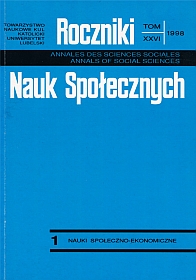Obrzędy pogrzebowe jako rytuały przejścia
Abstrakt
According to the authors, the phenomenon of death may at least be viewed in two dimensions. If we define “life” as “a group of specific phenomena of forms and motions, as they are externally perceived, pertaining to people, animals and plants,” then death and our knowledge about it is only an outcome of the empirical perception of the phenomenon of the “parting” of other people and animate beings. Now if “life” as such becomes a subject matter of reflection, in other words, if we know that we are dying, then the fact of dying becomes an integral element of human culture.
The analysis of the relationship between the ritual of transition and the fact of death is brought home to us by a number of anthropological conceptions pertaining to the ritual, starting from the classical “model” of the ritual of transition by Arnold van Gennep, through the theoretical considerations by Victor Turner, to the “new anthropology” of Clifford Geertz. By a ritual the authors have in minds stereotypical behaviours, the behaviours that repeat themselves, thereby being predictable as regards their form. The religious symbols are attendant on them. We find the rituals of transition in the “border-line” moments of life, i.e. they are celebrated on the occasion of birth, initiation, marriage and death.
Turner, who developed the classical theory of van Gennep, pinpoints that the ritual deals with the events which are not controlled by technology, and at the same time they are associated with mystic powers.
According to Max Gluckham, the rituals of transition may be thoroughly explained in terms of social relations. They serve to mark the division of social roles wherever they are vague and/or confused. The ritualization of everyday relations does not follow from the consciousness “immersed” in holiness, but from the diversity of social aims and roles, which an individual plays within a community and in relation to other individuals, and of parts of everyday life. The rituals express, however, unity despite real conflicts.
Now Geertz, the American anthropologist, speaks about order not only at the socio-political level. He combines the phenomenological method with the condense description of the so-called new anthropology, an anthropology that he advocates. Among many cultural symbols he distinguishes those which point to a general idea of order, being in opposition to chaos. Now chaos, according to Geertz, may intrude into our interior at least at three levels: cognitive, emotional and ethical. The fact of death is an event which pushes to the extremes the sense of chaos.
It is the holistic approach to the ritual reality as a condense image of both the structure and culture of a group that decides, according to Turner, about a possibility to code the symbolic rituals. At the liminal stage of the rite of transition the symbols become particularly intensified, the moment at which the principal form of communitas is revealed as a kind of social anti-structure. That structure is constructed by virtue of a binary opposition of traits which may easily be identified, e.g. totalitarity-particularity, the old order-the new order. In such circumstances, emotionally tense, the process of communication is carried out through the retainment of the axiomatic principles drawn from the sacerrima. The persons taking part in the ritual learn the social norms and values and about the order of reality along with the necessity of death.
Copyright (c) 1998 Roczniki Nauk Społecznych

Utwór dostępny jest na licencji Creative Commons Uznanie autorstwa – Użycie niekomercyjne – Bez utworów zależnych 4.0 Międzynarodowe.


